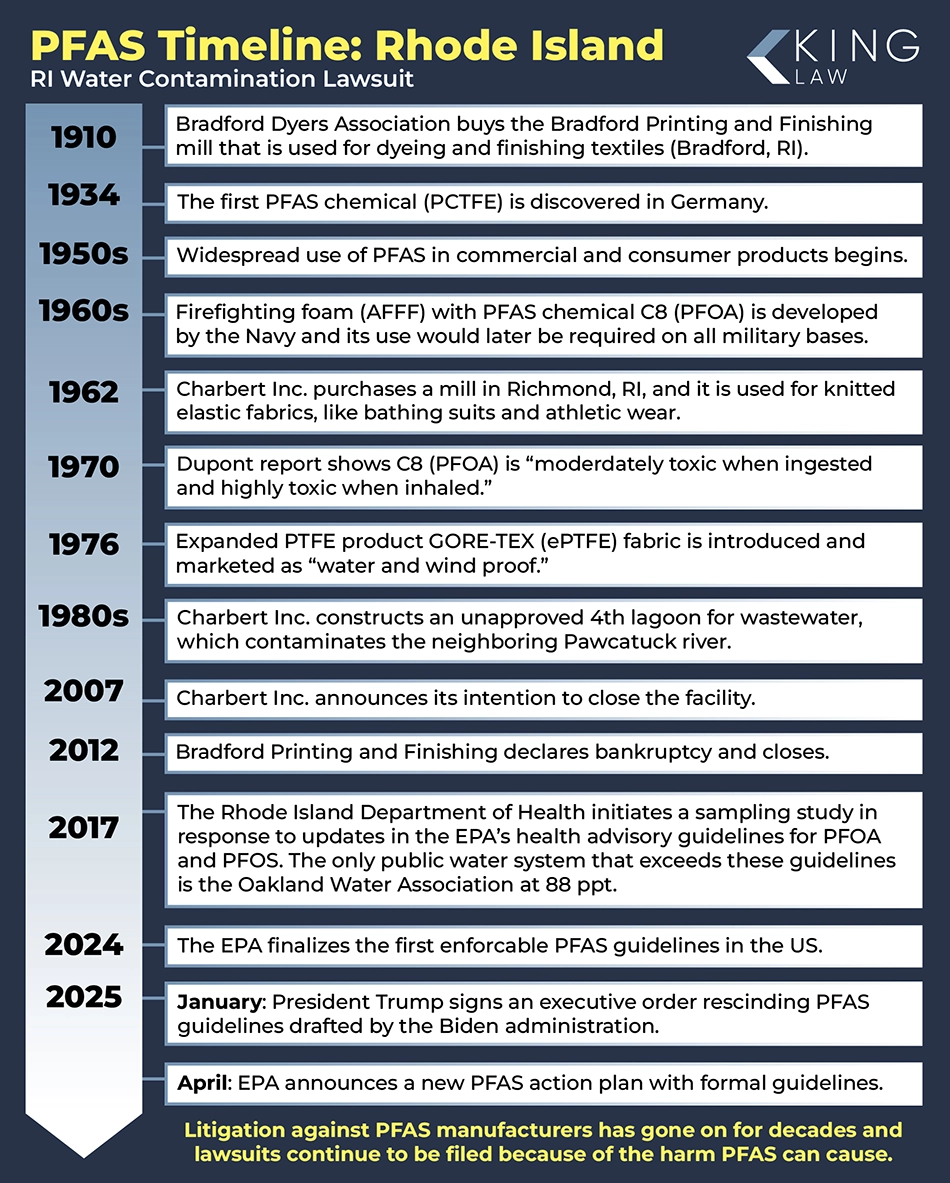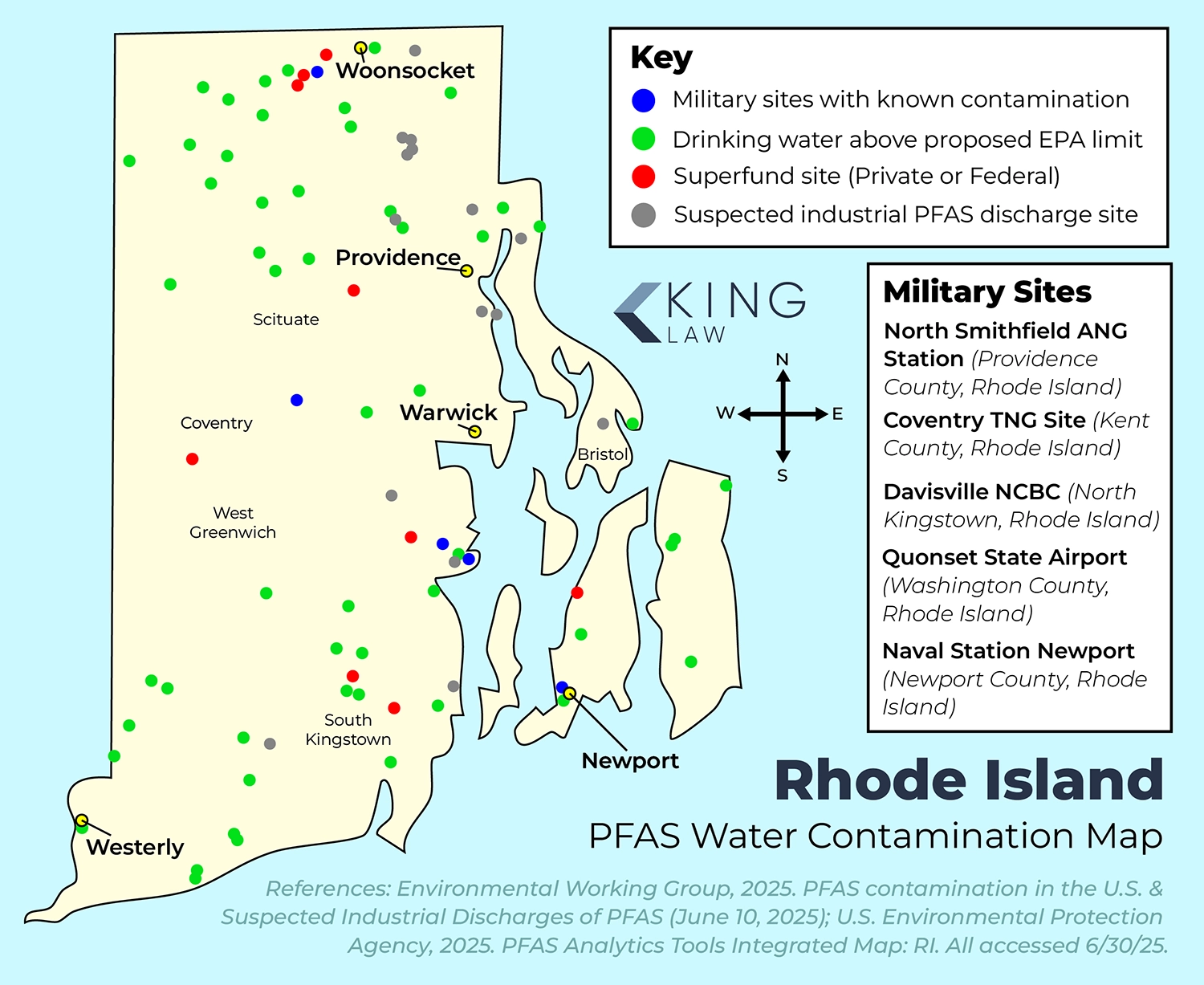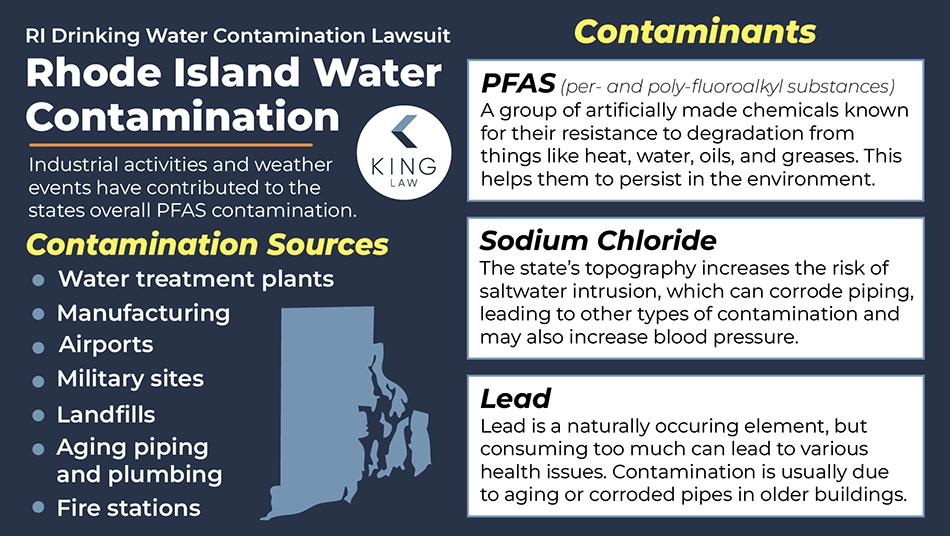
Oceanside Rhode Island is known for its “Blue Economy,” but the state’s relationship to its natural resources also includes water contamination. Rhode Islanders who consume water contaminated with toxins like PFAS or lead have a higher risk of developing serious health conditions. Some of these individuals and municipalities are fighting back by filing lawsuits against the companies that polluted Rhode Island’s water supplies.
Rhode Island Water Contamination
Though Rhode Island’s modern economy is more known for education, research, and tourism, the state has played host to manufacturing facilities. For example, textile plants in the state released toxic chemicals into the environment. Among the more worrisome pollutants in Rhode Island are PFAS (per- and polyfluoroalkyl substances). These human-made substances were widely used at military bases and fire stations to suppress fires. These substances, sometimes called “forever chemicals” due to their ability to persist in nature, can accumulate in the body and cause numerous health problems. People exposed to PFAS in their drinking water or by other means can have higher rates of cancer, decreased fertility, childhood developmental issues, and reduced immune function.
A 2023 report found that 14 (8%) of Rhode Island’s 170 public water systems were out of compliance with the state’s interim PFAS guidelines, putting residents in these communities at higher risk of developing these serious health problems.
As the government of Rhode Island begins to address the dangerous levels of these chemicals in drinking water, residents who have been injured by PFAS and other dangerous substances can seek compensation for harm suffered. Law firms like King Law are helping people pursue these claims.
Timeline of Water Contamination in Rhode Island | 2025 Update
Water contamination laws are evolving at the state level in Rhode Island and at the federal level. Here’s a recent timeline of water contamination-related news in Rhode Island.
April 2025: The EPA (U.S. Environmental Protection Agency) announces a new action plan for PFAS, along with a new liability framework for water contamination.
January 2025: The Trump Administration rolls back proposed Biden-era guidelines that would have established a federal limit on PFAS levels in drinking water.
September 2024: Rhode Island passes an amendment to its Public Drinking Regulations, establishing monitoring guidelines for six PFAS. It establishes an MCL (maximum contaminant level) of 20 ppt (parts per trillion).
July 2024: Rhode Island passes RI H7356, a bill that bans PFAS in consumer products sold within the state, with a phased rollout starting January 2025, with additional products scheduled to be banned in January 2027 and January 2029.
April 2024: The EPA outlines its first enforceable limits on PFAS contamination in drinking water.
October 2023: A report (cited above) finds that 3% of all Rhode Islanders are impacted by public water systems that exceeded interim PFAS guidelines. Three water systems triggered a mandatory “do not drink” notice for having PFAS levels above 70 ppt.
March 2023: An EPA report shows an 8% increase in toxic chemical releases in Rhode Island in 2021. Copper and nitrate compounds made up the bulk of the release.
January 2023: The state passes amendments to the Rhode Island Lead Poisoning Prevention Act, which requires the replacement of lead service lines within 10 years.
September 2017: Brown University researchers detect PFAS levels in Oakland, RI drinking water exceeding 70 ppt.
About the Rhode Island Water Contamination Lawsuit
Rhode Island Water Contamination
Timeline of Water Contamination in Rhode Island | 2025 Update
Sources of Water Contamination in Rhode Island
Rhode Island’s Regulations for Drinking Water
Rhode Island Water Contamination Map
Contaminants Found in Rhode Island’s Drinking Water
Current Water Quality in Rhode Island
Health Risks and Symptoms Linked to Drinking Water in Rhode Island
Eligibility Criteria for the Rhode Island Water Contamination Lawsuit
Rhode Island Water Contamination Settlement and Payout Amounts
How to File a Rhode Island Water Contamination Lawsuit
Statute of Limitations for Rhode Island Water Contamination Claims
Sources of Water Contamination in Rhode Island
Water pollution in Rhode Island can be traced to many sources. Many human activities, along with naturally occurring weather events, can contaminate water sources or spread existing contamination. Industrial activities like textile manufacturing, leather-making, metal- and wood-working, and machinery cleaning all resulted in toxins being released into water, soil, and air in Rhode Island. Additionally, fire-fighting operations resulted in PFAS being released into water.
Sources of water contamination in Rhode Island include:
- Landfill runoff
- Industrial waste
- Firefighting (from AFFF fire-fighting foams)
- Airports and military bases
- Chemical spills and accidents
- Floods
- Sewage treatment
- Aging water systems
- Agricultural runoff
Every county in Rhode Island has reported some PFAS contamination above the EPA’s health advisory levels with the exception of Bristol County, though this is due to a lack of sampling within that county. Hot spots for PFAS include the Blackstone, Pawtuxet, and Seekonk Rivers, with very high levels detected in the Oakland section of Burrillville in the northwestern part of the state. Currently, Captain Isaac Paine School in Foster and the Bruins Plastics Company in Burrillville are both under “Do Not Drink” notices.
Water Contamination From Military Installations
Active and former military bases are among the largest sources of PFAS contamination. AFFF, which is a foam used to extinguish liquid fuel fires, were commonly used on-site to suppress fires. AFFF resulted in water contamination at military installations in Rhode Island and across the nation.
Military sites that have tested positive for PFAS contamination within Rhode Island include:
- North Smithfield ANG Station (2017): 19.6 parts per trillion (ppt) for total PFAS
- Coventry TNG Site (2017): 61.2 ppt for total PFAS
- Davisville NCBC (2011): 23.1 ppt for PFOA and PFOS
- Quonset State Airport (2018): 2,865 ppt for PFOA and PFOS
- Naval Station Newport (2018): 20,420 ppt for PFOA and PFOS
Rhode Island’s Regulations for Drinking Water
Rhode Island and the federal government both set regulations governing drinking water. Some of these regulations have been around for quite some time, while others, like those governing PFAS, are relatively new.
- PFAS: The State of Rhode Island currently tracks six PFAS (PFOA, PFHxS, PFNA, PFHpA, and PFDA). PFAS levels above 20 ppt trigger public advisories, with the offending system given 180 days to enter an agreement with the Rhode Island Department of Health to lower levels. Samples above 70 ppt trigger a Do Not Drink notice.
- Lead: Federal regulations set the threshold for action on lead contamination at 15 ppb (parts per billion).
- Copper: The federal action level for copper is 1.3 ppm (parts per million).
- Arsenic: The EPA sets the federal limit for arsenic at 10 ppb.
- Microbes: Rhode Island follows federal guidelines on microbial contamination.
- Radionuclides: Radioactive substances, whether naturally occurring or from nuclear facilities, can contaminate water sources. They are federally regulated.
Rhode Island’s drinking water is generally safe, with no PFAS detected in 58% of its drinking water systems. There are, however, hot spots where PFAS and other contaminants have been detected. Most of those spots are below the state’s threshold for action, but it should be noted that some states set the threshold lower than Rhode Island’s 20 ppt.

Rhode Island Water Contamination Map
Our contamination map shows where PFAS has been detected in water sources in Rhode Island. Many areas of high concentration are near military bases and airports that used aqueous film-forming foam (AFFF) to combat fires. Over time, however, PFAS and other contaminants can spread into groundwater and adjacent waterways.

Contaminants Found in Rhode Island’s Drinking Water
Drinking water contamination, whether by PFAS, lead, or other harmful substances, can cause numerous health problems, especially if consumed over a long period of time. These risks are often elevated in children, who can suffer developmental issues on top of other health issues.
Per- and Polyfluoroalkyl Substances (PFAS)
PFAS are a class of manmade organofluorine chemicals used for a variety of purposes, including fire suppression, stain-resistant clothing and carpeting, and non-stick cookware and food packaging. The carbon-fluorine bonds in PFAS are incredibly strong and resistant to decay. The PFAS category includes thousands of chemicals, but of particular concern are PFOA, PFOS, PFHxS, PFNA, and GenX.
PFAS water contamination is a concern throughout the state of Rhode Island. Unsafe levels of these chemicals are linked to:
- Birth defects
- Bladder cancer
- Breast cancer
- Changes in liver enzymes
- Decreased vaccine effectiveness
- Hodgkin’s and non-Hodgkin’s lymphoma
- Leukemia
- Lowered immune response
- Multiple-myeloma
- Kidney cancer*
- Liver cancer*
- Pancreatic cancer
- Prostate cancer
- Reproductive issues
- Testicular cancer*
- Thyroid cancer*
- Thyroid disease*
- Ulcerative colitis*
*King Law is accepting cases for these conditions
Lead
Lead is a heavy metal found in nature, but lead-contaminated water is almost always the result of human activity. Among the most common sources of lead contamination are old, degrading water systems. Due to their age, public school buildings are often sites of lead contamination.
Lead exposure/lead poisoning can lead to:
- Behavioral problems, particularly in children
- Developmental issues
- Kidney damage
- Neurological damage
- Seizures
- Death (in large enough quantities)
Sodium Chloride
Rhode Island’s generally low-lying coastal topography leaves some of its groundwater vulnerable to saltwater intrusion. This can be a problem for households and businesses using well water. Droughts, rising sea levels, and storm surges raise the risk of saltwater contamination.
Saltwater can corrode piping, raising the risk of other types of contamination. Elevated salinity in drinking water has been linked to higher blood pressure.

Current Water Quality in Rhode Island
Water quality within Rhode Island varies by region. PFAS have been detected in 42% of public drinking water systems, however, only 8% exceeded the state’s current regulations, passed in 2022, of 20 ppt. Problem sites are dispersed throughout Rhode Island’s small geographic footprint.
Lead contamination is more prevalent in Rhode Island’s poorer urban areas, like Central Falls, which tend to have older, unrenovated housing stock. Saltwater contamination is more likely near the coast.
Water Treatment Efforts in Rhode Island
Rhode Island is currently pursuing a two-pronged approach to dealing with PFAS. The first is to test drinking water systems for six PFAS chemicals and trigger alerts and action plans when contamination exceeds 20 ppt. The other is to ban PFAS in consumer goods, with a phased rollout beginning in 2025.
Rhode Island’s Lead Hazard Mitigation Act requires most rental properties to maintain a valid Certificate of Lead Conformance, and the state is currently implementing a plan to replace aging lead piping systems throughout the state.
Health Risks and Symptoms Linked to Drinking Water in Rhode Island
Drinking water contamination can have serious health effects, as illustrated by high-profile cases on military bases like Camp Lejeune and Fort Ord.
Water contamination has been linked to:
- Neurological conditions
- High cholesterol
- High blood pressure
- Development delays
- Kidney cancer
- Testicular cancer
- Thyroid cancer
- Thyroid disease
- Ulcerative colitis
- Bladder cancer
- Non-Hodgkin’s lymphoma
- Hodgkin’s lymphoma
- Leukemia
- Male breast cancer
- Prostate Cancer
- Liver Cancer
If you believe you’ve been exposed to dangerous levels of water contaminants, you should schedule a screening and/or regular checkups with your healthcare provider.
Eligibility Criteria for the Rhode Island Water Contamination Lawsuit
Eligibility for a Rhode Island water contamination lawsuit, individuals is based on the following criteria:
Exposure: You must have lived or worked in the state for at least six months during an identified contamination period.
Specific Diagnoses: Our firm is evaluating cases with a diagnosis of:
Supporting Documents: You’ll want to provide as much supporting documentation as you can to demonstrate that you were present in and affected by a contaminated area. This includes medical records, proof of residence, and proof of employment (if work placed you in a contaminated area).
Rhode Island Water Contamination Settlement and Payout Amounts
Settlement amounts for Rhode Island water contamination lawsuits can vary significantly, with most falling in the range of $30,000 to $300,000. The size of the payout takes into consideration the extent of the exposure and the amount of harm suffered from it. Working with a law firm experienced in water contamination lawsuits can provide guidance on the strength of your case. Water contamination lawsuits may take a year or more to reach a settlement or resolution.
How to File a Rhode Island Water Contamination Lawsuit
If you want to file a strong water contamination lawsuit in Rhode Island, you can expect to take the following steps:
Get A Consultation: Water contamination lawsuits are complex and time-consuming. By getting a free consultation with an experienced attorney, you can gauge the strength of your case and develop a plan to file your lawsuit.
Collect Personal Evidence: The strength of your case will depend greatly on the amount and quality of the evidence you’re able to provide. Your attorney can help you determine what you need to proceed.
Legal Filing: Your attorney will submit the necessary legal documents to establish your claim. Cases must be filed within the state’s statute of limitations. This is typically up to three years from the date of the injury in Rhode Island. However, if you only recently discovered your injuries might be related to PFAS, you may still be able to file a case.
Pre-Trial: This is when both sides of the case initially exchange evidence and may conduct interrogations and review depositions from experts and company representatives.
Negotiations: During this phase, your attorney will attempt to reach a settlement with the defendant’s representation.
Trial: In cases where a settlement cannot be reached, the case will go to trial. A judge or jury will determine what, if any, damages are awarded.
Many people who choose to file lawsuits against PFAS manufacturers will join the group lawsuit for PFAS contamination. This multidistrict litigation is called IN RE: Aqueous Film-Forming Foams Products Liability Litigation. It represents people and water utilities who were harmed by chemical manufacturers who made PFAS.
Evidence to Support Your RI Water Contamination Claim:
Supporting evidence will form the backbone of your water contamination claim. Here’s what you’ll want to look for:
- Environmental Studies: Your attorney’s team will work to gather expert evidence. These may include reports by Rhode Island’s Health Department, academic studies, and similar items that establish that a water system was contaminated, when it was contaminated, and what it was contaminated with. They can also outline the health risks associated with drinking contaminated water.
- Medical Documents: In order to pursue a water contamination lawsuit, you’ll need to demonstrate that you suffered a related injury. A medical diagnosis of a condition linked to water contamination will support your case. You will work with your medical providers to gather documents for your case.
- Proof of Residency/Employment: Showing that you lived or worked in a contaminated area will help link your medical diagnosis to the water contamination. Proof of employment, leases, home ownership, and utility bills can establish your presence and residence.
- Bills and Receipts: These can help establish any economic losses you suffered due to your exposure, such as medical bills.
- Testimonies: Medical and science professionals can help link your medical condition to water contamination.
Statute of Limitations for Rhode Island Water Contamination Claims
Lawsuits like water contamination claims are subject to a statute of limitations, meaning they must be filed within a specific window of time. In Rhode Island, the typical statute of limitations for personal injury lawsuits is three years. However, the specifics of your case may affect your filing window, such as when you discovered your injury or whether a minor is involved. If you recently discovered your prior illness might have been caused by PFAS, you may still have a case. Your attorney can help you determine if any extensions apply to your case.
Rhode Island Water Contamination Lawyers
King Law offers extensive experience in water contamination lawsuits in multiple states, including Rhode Island. Our firm focuses on municipal, military, and civilian PFAS contamination cases, and can help evaluate your claim, prepare documentation, and represent you throughout the process. Contact us today for a free, no-obligation consultation.

